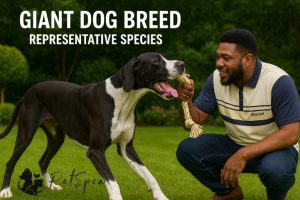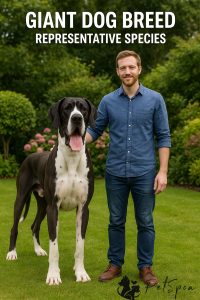When it comes to canine companions, Few dog breeds inspire as much awe and admiration as the giant breeds. These gentle giants are known for their imposing stature, loyal nature, and often surprisingly calm demeanor. For those considering adding a giant breed dog to their family, understanding the most representative species, their characteristics, and even which giant breed dog lives the longest is essential.

In this comprehensive guide, we’ll explore the most iconic giant breed dogs, their unique traits, and what makes them such beloved pets. Whether you’re drawn to the massive yet gentle Great Dane or the protective and fluffy Tibetan Mastiff, there’s a giant dog breed to suit every lifestyle.
What Defines a Giant Dog Breed?
Giant dog breeds are typically classified by their weight and height. While definitions vary, most experts agree that a giant breed dog weighs at least 100 pounds (45 kg) and stands over 26 inches (66 cm) tall at the shoulder. These dogs often have a slower growth rate, taking up to two years to reach full maturity, and require special care to support their large frames.
Even though they are very big, many giant dog breeds are gentle and loving, which makes them great family pets. However, their sheer size means they need ample space, proper nutrition, and regular veterinary care to thrive.

Top Giant Dog Breed Representative Species
-
Great Dane – A Big Dog with a Gentle Heart
Category Range Average Height 28–34 inches Average Weight 110–175 pounds Lifespan 7–10 years The Great Dane is a famous giant dog breed, known for its tall and proud look. That’s why people often call it the ‘Apollo of Dogs. Known for their towering height and elegant build, Great Danes are surprisingly gentle and affectionate. Originally bred for hunting wild boars, they have since become beloved family pets.
Despite their short lifespan, Great Danes make a lasting impression with their friendly demeanor and loyalty. They require moderate exercise and thrive in homes where they can stretch their long legs. -
Mastiff – The Gentle Guardian
Category Range Average Height 27–30 inches Average Weight 120–230 pounds Lifespan 6–10 years The English Mastiff was discovered as one of the biggest dogs and can weigh more than two hundred and thirty pounds. Even though they look big and tough, they are usually calm and very loyal. Mastiffs make great guard dogs and are also very loving with their families.
Due to their massive size, Mastiffs need controlled exercise to prevent joint issues. Early socialization is crucial to ensure they remain well-mannered around strangers and other pets. -
Saint Bernard – The Alpine Rescuer
Category Range Unit Average Height 26–30 inches Average Weight 140–180 pounds Lifespan 8–10 years Famous for their role in alpine rescues, Saint Bernards are gentle giants with a strong sense of loyalty. Their thick fur and muscular build make them well-suited for cold climates, but they adapt well to family life.
Saint Bernards are very patient, especially with kids, which makes them great family dogs. -
Newfoundland – The Lifesaving Sweetheart
Category Range Unit Average Height 26–28 inches Average Weight 100–150 pounds Lifespan 9–10 years Newfoundlands, or “Newfies,” are renowned for their swimming abilities and sweet temperament. Originally bred as working dogs for fishermen, they have webbed feet and a water-resistant coat.
These big, gentle dogs are very patient and protective, which makes them great for families with kids. Their thick fur needs regular brushing to keep it from getting tangled. -
Irish Wolfhound – The Tallest Dog Breed
Trait Range Unit Average Height 32–34 inches Average Weight 120–180 pounds Lifespan 6–8 years Because they drool and shed frequently, they require regular grooming and cleaning.. Historically used for hunting wolves, these dogs are surprisingly gentle and affectionate.
Despite their size, Irish Wolfhounds are relatively low-energy indoors but need ample space to run. Their short lifespan is a drawback, but their loving nature makes every moment with them precious. -
Tibetan Mastiff – The Ancient Protector
Trait Range Unit Height 24–26 inches Weight 70–150 pounds Lifespan 10–14 years Unlike other giant breeds, the Tibetan Mastiff is more compact but still falls into the giant category due to its robust build. Known for their lion-like mane and fierce loyalty, these dogs were originally bred to guard livestock in the Himalayas.
Tibetan Mastiffs are strong-willed and protective, so they’re a better match for people who have experience with dogs. They thrive in cooler climates and require consistent training to manage their strong-willed nature.
Which Giant Breed Dog Lives the Longest?
Among giant breed dogs, the Tibetan Mastiff stands out with a lifespan of 10–14 years, making it one of the longest-living giant breeds. Other breeds, such as the Great Dane and Irish Wolfhound, typically live between 6–10 years, while the Newfoundland and Saint Bernard average 8–10 years.
Many things can affect how long giant dog breeds live:
- Genetics: Some dog breeds are more likely to have certain health problems.
- Diet: Eating the right food helps prevent weight gain and joint problems.
- Exercise: Moderate activity helps maintain muscle and joint health.
- Veterinary Care: Regular check-ups can detect early signs of common giant breed ailments like hip dysplasia and heart disease.
Caring for a Giant Dog Breed
Owning a giant breed dog comes with unique responsibilities. Here are essential care tips:
-
Proper Nutrition
Giant breeds require high-quality, large-breed-specific dog food to support their bone and joint health. Avoid overfeeding, as obesity can exacerbate health problems.
-
Regular Exercise
While giant dogs don’t need excessive exercise, daily walks and playtime are essential to keep them fit and mentally stimulated.
-
Joint and Bone Health
Because they’re so big, giant dog breeds often have joint problems like hip dysplasia and arthritis. Supplements such as glucosamine can help keep their joints healthy.
-
Early Training and Socialization
Training should start early to ensure good behavior. Socialization helps prevent aggression or fearfulness in large dogs.
-
Space Considerations
Giant dogs need ample space to move comfortably. A house with a large yard is ideal, though some adapt well to living in an Apartment with a Giant Dog Breed: What You Need to Know
Common Questions About Giant Dog Breeds
-
What are the most popular giant dog breeds?
Some of the most cherished large dog breeds are the Great Dane, Mastiff, Saint Bernard, Newfoundland, and Irish Wolfhound. These dogs are known for their impressive size, gentle personalities, and deep loyalty, making them wonderful companions for the right owner.
-
Are giant dog breeds good with kids?
Many giant breeds are famously gentle and patient with children, earning them the nickname “gentle giants.” Breeds like the Newfoundland and Saint Bernard are especially known for their calm demeanor. However, because of their size, it’s important to supervise interactions to prevent accidental knocks or falls.
-
Do giant dogs need a lot of space?
While they don’t necessarily need a huge house, giant breeds do best with enough room to move comfortably. A home with a yard or nearby park is ideal, but regular exercise and mental stimulation can help them adapt to apartment living as long as their needs are met.
-
What’s the average lifespan of a giant dog breed?
Unfortunately, larger dogs tend to have shorter lifespans, usually between 6 to 10 years. Their rapid growth and size can contribute to health issues like joint or heart problems. However, proper nutrition, regular vet care, and a healthy lifestyle can help them live longer, happier lives.
-
How much food do large dogs need, and what kind of diet is best for them?
Giant breeds typically eat 4 to 8 cups of high-quality dog food daily, depending on their age, size, and activity level. Their diet should support joint health and muscle maintenance, so large-breed-specific formulas are often recommended. Be sure to talk to your veterinarian to find the most suitable feeding plan for your dog.
Final Thoughts
Giant dog breeds bring a special kind of love and companionship—their size may require extra effort, but their loyalty and affection make it worthwhile. If you’re considering adding one to your family, research breeds carefully to find the best match for your lifestyle. With the right care, these gentle giants can become cherished members of your household. Learn daily exercise and training habits for your dogs.

